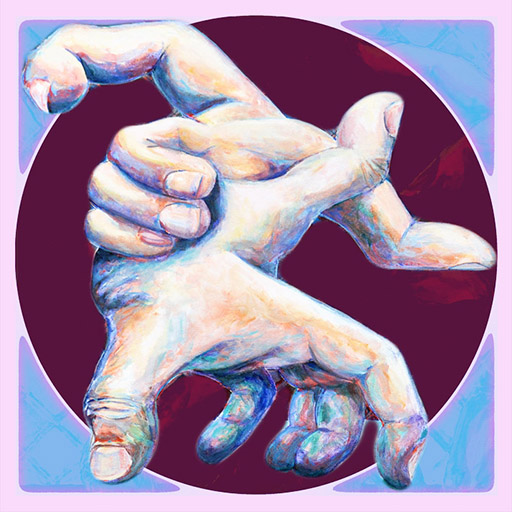
analogue and digital figurative art full of imagination

analogue and digital figurative art full of imagination

acrylverf op aquarelpapier (1,5 x 10 m, 2018)
collective individualism
Over the past fifty years, everyone has been increasingly involved in the search for and shaping the own identity in the same way. Together, each for himself or herself.
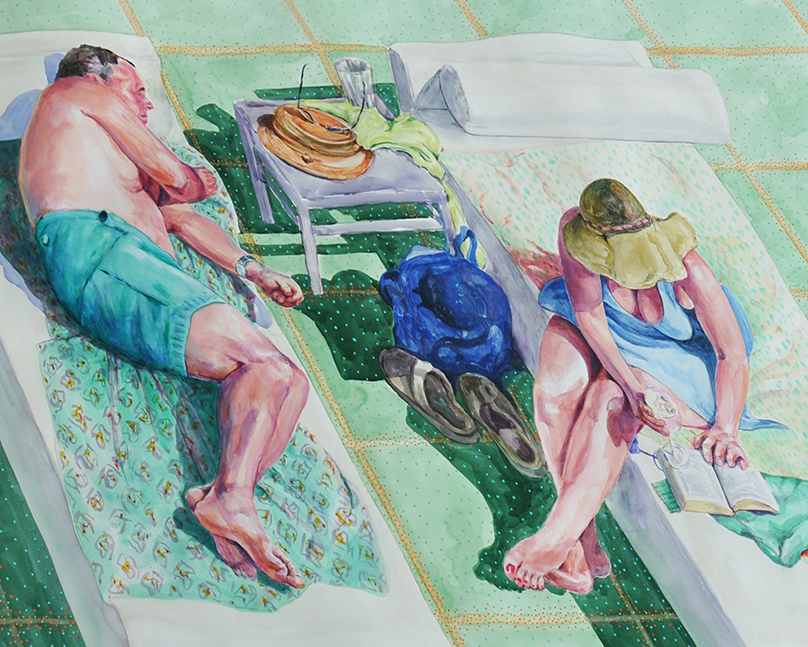
The sunbathers have Apollinian and Dyonisian traits. On the one hand, harmony and balance, the peace and quiet of sunbathing, depicted in a painting that must be viewed in silence. On the other hand, laziness and indulgence, the addiction, the frivolous exposure of the body to excessive sunlight in order to satisfy a beauty terror, an ideal image of holidays as an expression of aversion to work. It is a light version of going on a razzle, in which people mix traits of tragedy with traits of comedy. The comedy is staged to disguise the tragedy. The sunbathing human shows traits of both forms of theatre; it is a comic showcase of excess shiny smeared flesh, a tragic attempt to deny impermanence.
Sunbathing is an early expression of “collective individualism”, a phenomenon that has become characteristic of the digital world, especially in social media. Collective Individualism, mass individualism, the hallmark of the digital age, also existed before we were given more leisure time and could therefore be more self-focused.
We exhibit herding behavior, superficiality with subtle nuances that we call profound when it comes to ourselves. Is the individual still interested in the other? Don’t we all want to be unique when we can’t be? In the effort to be perfect, we take the increased risk of skin cancer for granted. After all, we are so confident that we assume that disaster will not happen to us. Is this exclusively holiday behavior or have we collectively dozed off, are we burying our heads in the sand?
Ignoring the long term is congenital. Evolution is a long-lasting slow process for which nevertheless the short-term survival of individuals is conditional. We are evolutionarily programmed to focus on tomorrow and for later, whoever lives then takes care of it. Short term pleasure takes precedence over future danger, think of climate change, environmental pollution and population growth.
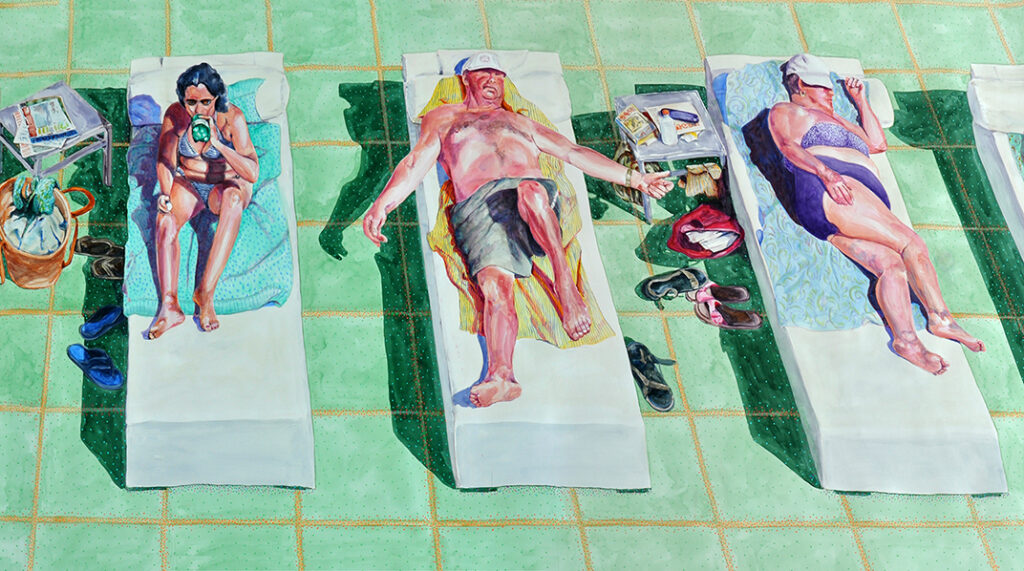

acrylic on watercolor paper (1,5 x 10 m, 2018-2019)
near distance
The contemporary variant of “collective individualism”, the smartphone users are always busy, always moving mentally but standing still in the physical space, waiting for something. They all seem as isolated from the other as the sunbathers, but are often in contact with others, not with the people in physical proximity, but with the whole world.
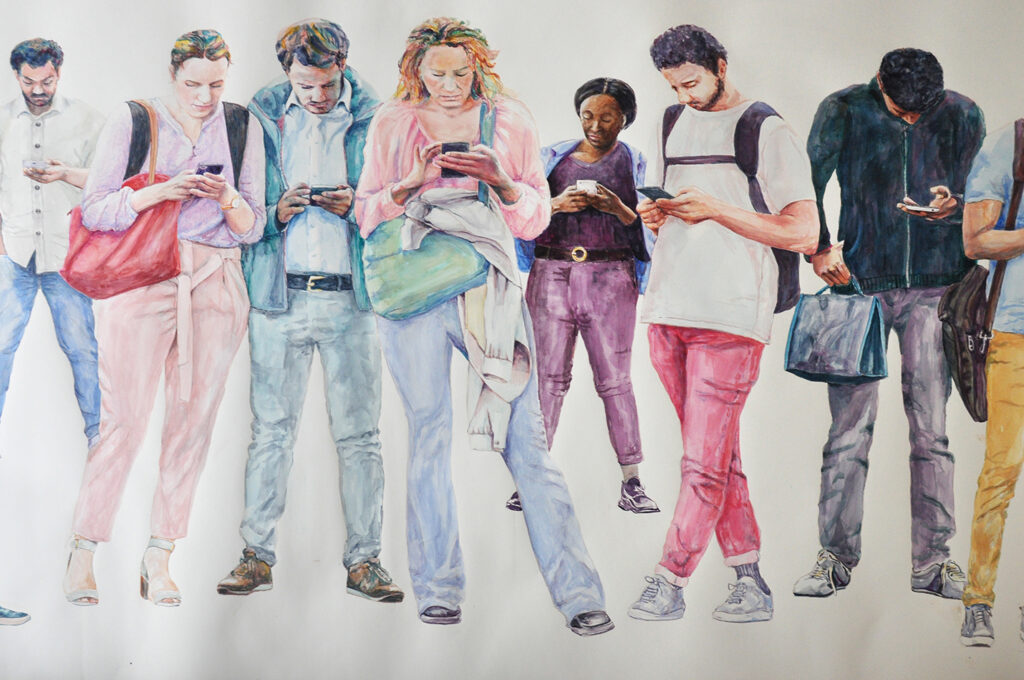
People are constantly traveling, often without a clear destination. Traveling means waiting. Being on the road seems like a continuous process, but it takes place in steps and consists largely of waiting. I can try to escape from that often unpleasant physical situation of waiting with cold and wetness, by traveling around in the digital world with myself, my self, my mind, while my body stays behind in the analog world.
The smartphone is an extension of the human being. As we previously had prostheses such as glasses, hearing aid, dentures, camera, now almost everyone has a multifunctional smartphone, containing a camera, route planner, make-up mirror, flashlight, communication aid, atlas, encyclopedia, newspaper, book, film, series, music, shopping malls, travel agency and museums etc. The digital world is stacked on top of the analog and we are constantly bouncing back and forth. They are two separate ecosystems.
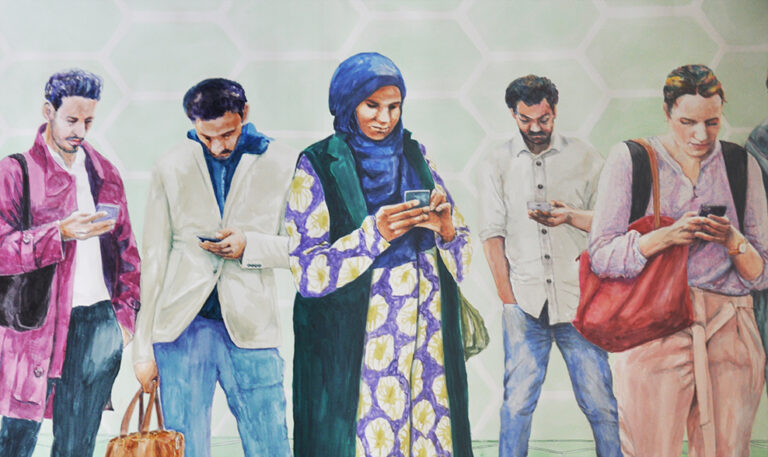
An individual alone has no meaning, only in his design compared to others and in relation to those others does the individual become a human being.
Clothing, footwear, hairstyle, backpack and smartphone are mass-produced consumer items in which everyone tries to find a unique combination that suits the person and personality. Everyone wants to distinguish themselves as an individual in the collective, wants to be unique with goods from mass production. In the profusion of images in social media, in fashion and art, it is increasingly difficult to let the ordinary be special because so many specialities are already experienced as ordinary. Does the swirling, overheated visual culture that we always have available stimulate our own imagination and fantasy or are we actually inhibited in this?
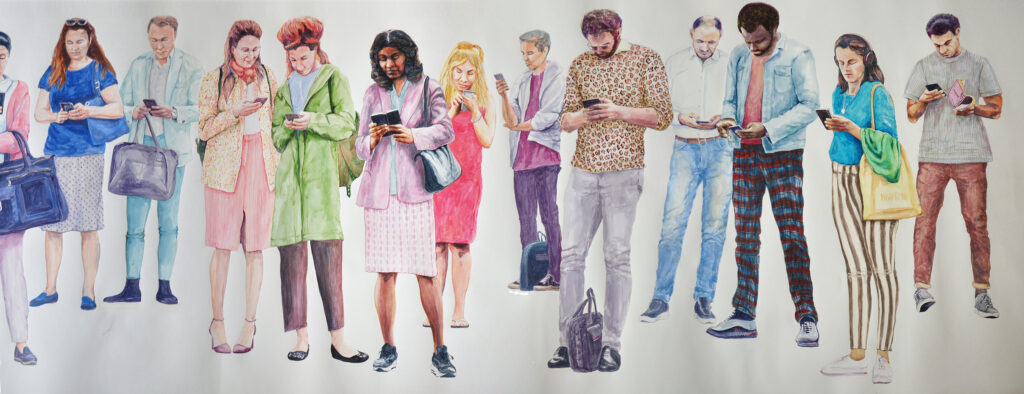
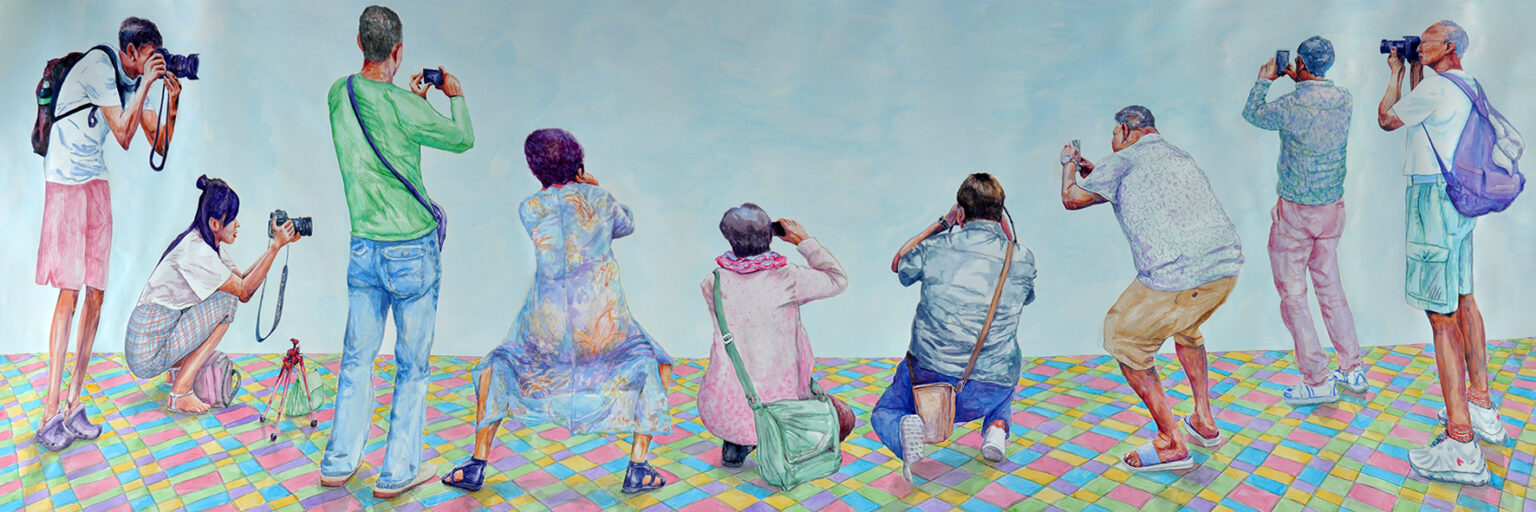
acrylverf op aquarelpapier (1,5 x 5 m, 2019)
together at a distance
Like the sunbathers, the photographers are a reference to mass tourism, a phenomenon that stems from collective individualism. Everyone is busy with themselves, especially the tourist who is always a spectator, just as everyone is often a spectator in the world stage as well as in the immediate vicinity. There are always spectators and the question is always do I want to be a spectator or a participant? Do I want to be in touch with the world or just watch? Not choosing is also a choice.

The photographers are busy capturing the past for the future and are already looking at the past through their camera as they want to experience it in the future. They choose their subjects based on what they think that they and their loved ones, relatives and friends want to see in the future, just as the painter creates a painting with in mind what unknown audiences might appreciate in an unknown future.
Above all, the photos must provide a justification afterwards of the journey that has been undertaken, of the visit made. The photo is proof that you have experienced something, but you keep hoping that it will bring back something of what you experienced, from the experience itself.
Photos often do not show that we all see something different depending on who we are. The cabinetmaker sees furniture everywhere, the alcoholic sees glasses and especially bottles, the young mother watches children and the painter sees paintings and if we give freedom to the photographer in us, he captures who we are.
We don’t see what the other sees. Everyone seems to look differently. We look at the earth, at a cloud, at light and shadow, at buildings, landscapes, at crowds of people, and yet we usually capture the same thing as the other and we actually look at nothing and take for granted that quite often there is a photographing fellow tourist appearing in our shots.
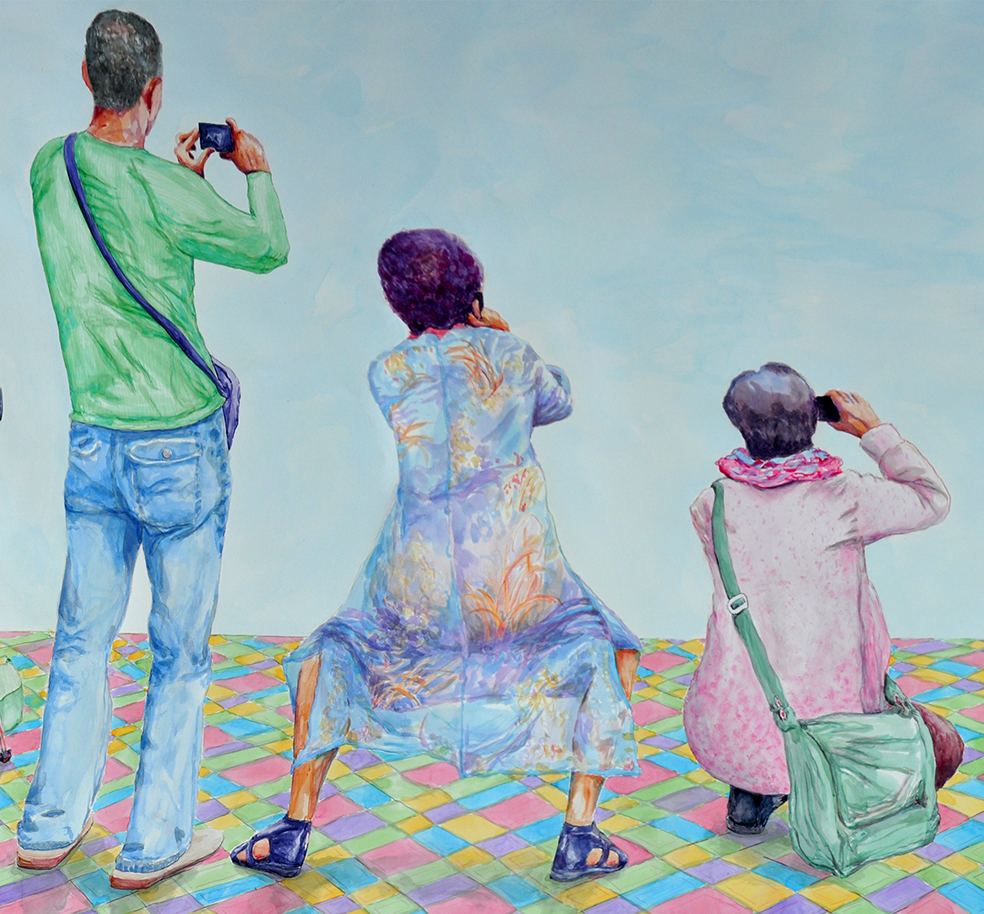
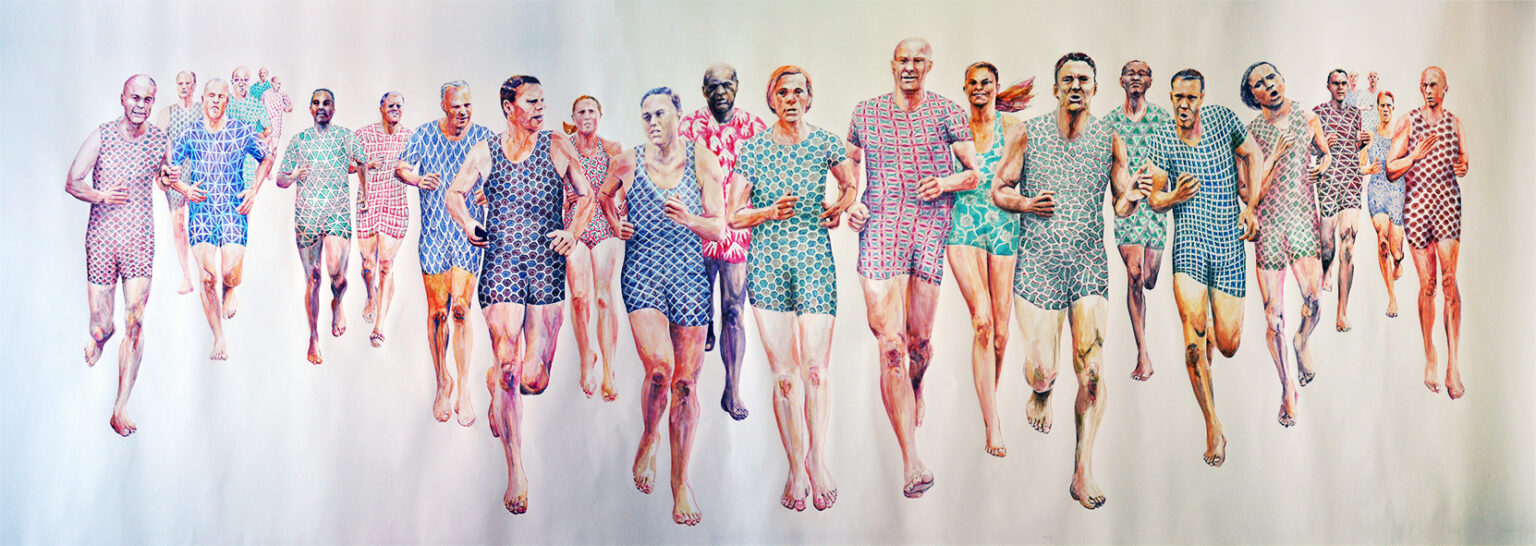
acrylverf op aquarelpapier (1,5 x 7 m, 2020)
runners, trailblazers, runaways, followers
Even more collective individualism. The runners with their playsuits want to be the same but still different, to belong to but to remain themselves, to feel supported in the group but with the illusion of individual freedom. We look for structure in the group, we look for recognizable patterns in which we can fit ourselves.
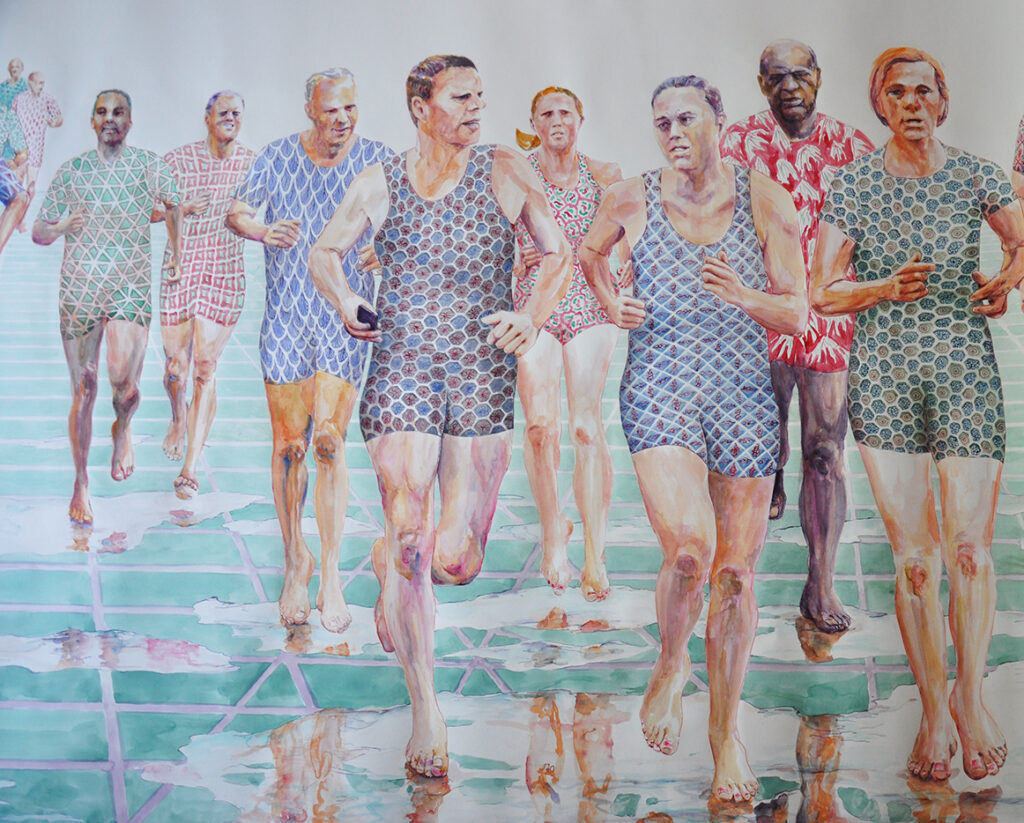
Play, playfulness, mobility are elements that occur in groups in countless manifestations. Competition inevitably arises in a group of individuals with ambition. As soon as there is movement, the competition element sneaks in. Sport is based on the individual need to stand out in the group, to excel and thus gain esteem and elevate status.
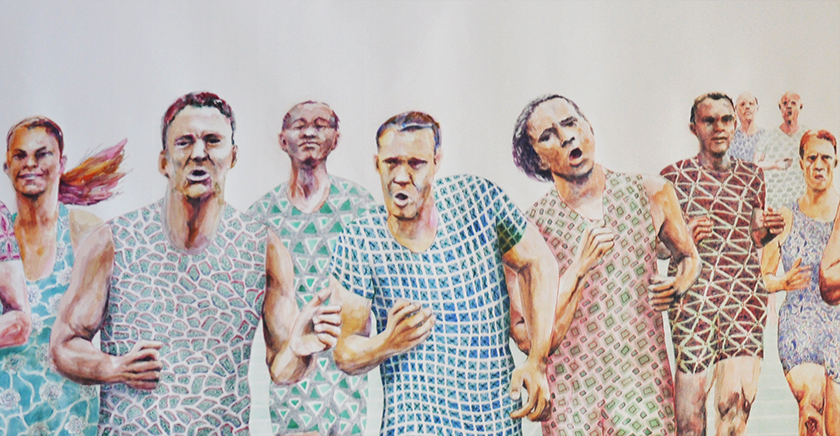
Leading the way, or in cover being carried along? Distinguishing or conforming to the group? Some look to the side to see if they are fast enough or not too fast? Is the mutual distance correct? Do I fit in here?
Leadership and status are inherent in group processes. There is one runner with a smartphone, a man who gives a woman a dash. A black man walks in the middle, but in the background. Perhaps they are politicians who involuntarily, occasionally looking at each other, run into the same direction without knowing exactly where to, in an empty and desolate world from which they have become estranged. You see them running towards you, but they don’t seem to see you as their target.